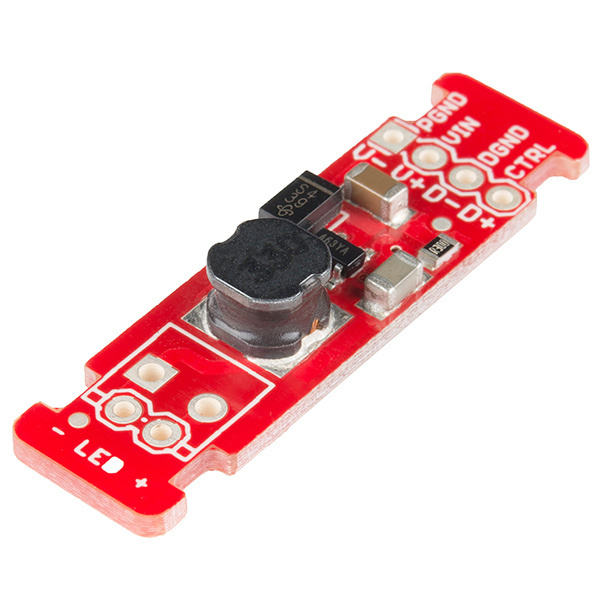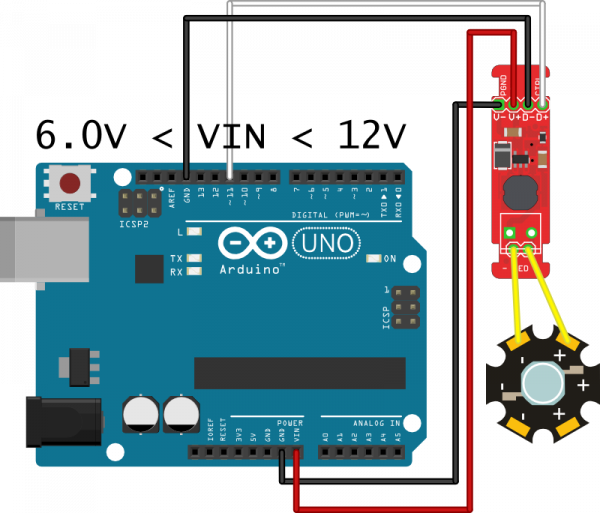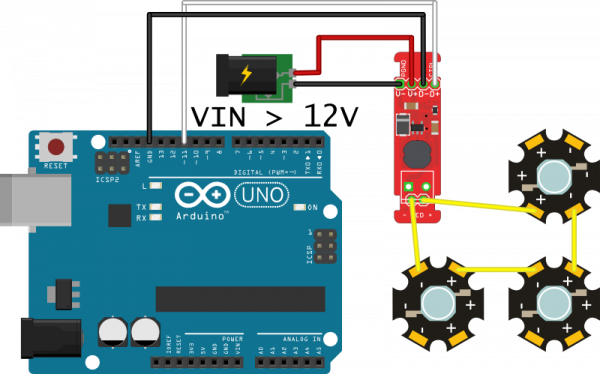RETIRED - FemtoBuck Constant Current LED Driver Hookup Guide
This Tutorial is Retired!
This tutorial covers concepts or technologies that are no longer current. It's still here for you to read and enjoy, but may not be as useful as our newest tutorials.
View the updated tutorial: FemtoBuck Constant Current LED Driver Hookup Guide v13
Introduction
The FemtoBuck is a small-size, single-output constant current LED driver. By default, the FemtoBuck is driven at 350mA. That current can be reduced by either presenting an analog voltage or a PWM signal to the board.
FemtoBuck LED Driver
COM-12937Suggested Reading
Here are some topics you should know before using the FemtoBuck. Have a look if you need more information.
FemtoBuck Overview
Connecting the FemtoBuck
For the FemtoBuck, we've increased the voltage ratings on the parts to allow the input voltage to cover the full 36V range of the AL8805. Note that the supply voltage must be at least 6.0V, and should be at least 2-3V higher than the forward voltage of the LED(s) to be driven.
Since the FemtoBuck is a constant current driver, the current drawn from the supply will drop as supply voltage rises. In general, efficiency of the FemtoBuck is around 95%, depending on the input voltage.
One signal input is provided for dimming control. A ground pin (DGND) is provided to reference against the controlling module for accuracy. Dimming can be done by an analog voltage (20%-100% of max current by varying voltage from .5V-2.5V) or by PWM (so long as PWM minimum voltage is less than .4V and maximum voltage is more than 2.4V) for a full 0-100% range.
Another ground (PGND) pin is available next to the power supply pin to provide a high-current return path. The spacing on the four holes on the input side is 0.1" for standard headers.
The output side has a 0.1" spaced hole pair as well as a 3.5mm spaced hole pair, to allow the user to attach our 3.5mm screw terminals.
Connecting to an Arduino
If you have only one or two LEDs, you can connect the FemtoBuck directly to the VIN pin on your Arduino. You will need to power the board from an external supply, as the 5V provided by USB isn't high enough to power the FemtoBuck.
If you have more than a couple of LEDs, you should provide an independent power supply from the Arduino. Multiple LEDs can be connected in series, as shown, and the supply voltage should be at least 2-3V higher than the sum of the forward voltages of the LEDs.
For instance, our blue 3W LEDs have a forward voltage of 3.2V to 3.8V. To be on the safe side, use the highest voltage in the range. If you want to connect three of them, you'd need a power supply of ~14V or greater (3.8V + 3.8V + 3.8V = 11.4V; add 2V of "head room").
Since 14V is greater than the Arduino can tolerate on its input, we have to provide an external supply.
Increasing current drive strength
It is possible to increase the maximum current of the FemtoBuck board up to 1A per channel. To do so, replace the current sense resistor with smaller values. To calculate the new value for the resistor, use this formula:
ILED = 0.1 / Rset
Thus, for a 1A current, you'd want a 0.1Ω resistor. Don't forget to be wary of current ratings; at 1A, the sense resistor will be dissipating 1/10W, so you probably want a resistor of at least 1/8W rating. The package is a standard 0805.
The "ears" on either end of the board allow you to use a zip tie to secure the wires to the board after soldering them down.
Finally, take note of the size of the FemtoBuck. If desired, the entire board can be slid into a piece of 9mm heat shrink tubing to provide insulation and strain relief.
Resources and Going Further
Consider checking out these other tutorials for more information about concepts in this guide:
- Light - Covers some useful concepts, such as why doubling the current doesn't appear to double the brightness.
- Diodes - Diodes are a slightly more complex beast than resistors. Our diodes tutorial will help you understand why we need a special device to power them.
- Pico Buck Hookup Guide - Need to control more LEDs? The PicoBuck is just like the FemtoBuck except it has three channels, each capable of providing 350mA. Perfect for controlling high powered RGB LEDS that require control of each color individually.



